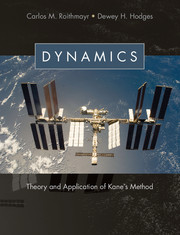Book contents
- Frontmatter
- Contents
- Preface
- Preface to Dynamics: Theory and Applications
- To the Reader
- 1 Differentiation of Vectors
- 2 Kinematics
- 3 Constraints
- 4 Mass Distribution
- 5 Generalized Forces
- 6 Constraint Forces, Constraint Torques
- 7 Energy Functions
- 8 Formulation of Equations of Motion
- 9 Extraction of Information from Equations of Motion
- 10 Kinematics of Orientation
- Problem Sets
- Appendix I Direction Cosines as Functions of Orientation Angles
- Appendix II Kinematical Differential Equations in Terms of Orientation Angles
- Appendix III Inertia Properties of Uniform Bodies
- Index
1 - Differentiation of Vectors
Published online by Cambridge University Press: 05 February 2016
- Frontmatter
- Contents
- Preface
- Preface to Dynamics: Theory and Applications
- To the Reader
- 1 Differentiation of Vectors
- 2 Kinematics
- 3 Constraints
- 4 Mass Distribution
- 5 Generalized Forces
- 6 Constraint Forces, Constraint Torques
- 7 Energy Functions
- 8 Formulation of Equations of Motion
- 9 Extraction of Information from Equations of Motion
- 10 Kinematics of Orientation
- Problem Sets
- Appendix I Direction Cosines as Functions of Orientation Angles
- Appendix II Kinematical Differential Equations in Terms of Orientation Angles
- Appendix III Inertia Properties of Uniform Bodies
- Index
Summary
The discipline of dynamics deals with changes of various kinds, such as changes in the position of a particle in a reference frame and changes in the configuration of a mechanical system. To characterize the manner in which some of these changes take place, one employs the differential calculus of vectors, a subject that can be regarded as an extension of material usually taught under the heading of the differential calculus of scalar functions. The extension consists primarily of provisions made to accommodate the fact that reference frames play a central role in connection with many of the vectors of interest in dynamics. A reference frame can be regarded as a massless rigid body, and a rigid body can serve as a reference frame. (A reference frame should not be confused with a coordinate system. Many coordinate systems can be embedded in a given reference frame.) The importance of reference frames in connection with change in a vector can be illustrated by considering the following example. Let A and B be reference frames moving relative to each other, but having one point O in common at all times, and let P be a point fixed in A, distinct from O and thus moving in B. Then the velocity of P in A is equal to zero, whereas the velocity of P in B differs from zero. Now, each of these velocities is a time derivative of the same vector, rOP, the position vector from O to P. Hence, it is meaningless to speak simply of the time derivative of rOP. Clearly, therefore, the calculus used to differentiate vectors must permit one to distinguish between differentiation with respect to a scalar variable in a reference frame A and differentiation with respect to the same variable in a reference frame B.
When working with elementary principles of dynamics, such as Newton's second law or the angular momentum principle, one needs only the ordinary differential calculus of vectors, that is, a theory involving differentiations of vectors with respect to a single scalar variable, generally the time. Consideration of advanced principles of dynamics, such as those presented in later chapters of this book, necessitates, in addition, partial differentiation of vectors with respect to several scalar variables, such as generalized coordinates and motion variables.
- Type
- Chapter
- Information
- DynamicsTheory and Application of Kane’s Method, pp. 1 - 18Publisher: Cambridge University PressPrint publication year: 2016



